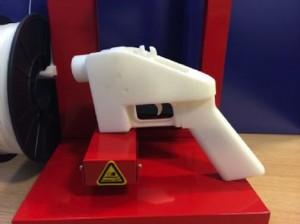3D-printed guns are subject of a lot of very heated debates, and a recent study conducted by NABIS (National Ballistics Intelligence Service), the firearms department of English police, will only add fuel to the fire of the discussion.
According to Tony Gallagher, NABIS Firearms Expert, 3D-printed guns “pose probably the greatest danger to the user”, not the target.
In a video released by the BBC, NABIS experts show 3D-printed guns being shot in a safe environment. In this very instance they used the 3D Liberator. Using slow-motion cameras, the English authorities show barrels exploding, pieces of plastic scattering everywhere, and even bits of the gun stuck in the ceiling.
However Cody Wilson, founder of Defense Distributed, the company that distributes the 3D Liberator printable gun, dismisses this study as propaganda.
In an interview with Computerworld, Wilson dismissed this study and two others, claiming that the authorities who conducted the studies, purposely didn’t follow the instructions given for printing the guns, causing them “to destruct for maximum spectacle.”
Although Wilson claims that he cannot comment on the English tests, he does say that two other studies, an American and an Israeli one, were carried out to mislead possible customers. Wilson points out, that the Israeli testers didn’t use “acetone vapor to treat the barrel.” He also claims that the ATF (U.S. Bureau of Alcohol, Tobacco, Firearms and Explosives) conducted tests on the 3D-printed guns, using springs not approved for use in the guns. In addition, Wilson brought up the fact that “Liberator springs don’t even work in the weaker materials that would make the gun explode.”
All three studies have shown 3D-printed guns to fail spectacularly and to be dangerous to the shooter. Others point to the materials and the printers used to print the guns, which both can have an impact on the quality and durability of the gun that is being shot.
Detective Chief Superintendent at NABIS, Iain O’Brien, commented on the tests: “We need to make people aware that producing a firearm in this way is illegal and could cause serious injury to the person holding the gun”.
Defense Distributed has managed to demonstrate that its guns can fire successfully, however they do acknowledge that the guns need to be replaced after 8 to 10 shots, which isn’t very practical for frequent use.
What do you think? Are these studies rigged, or do these guns in fact cause more danger to the shooter than his/her target? Discuss in the ‘Dangers of 3D Printed Guns’ thread on 3DPB.com.
